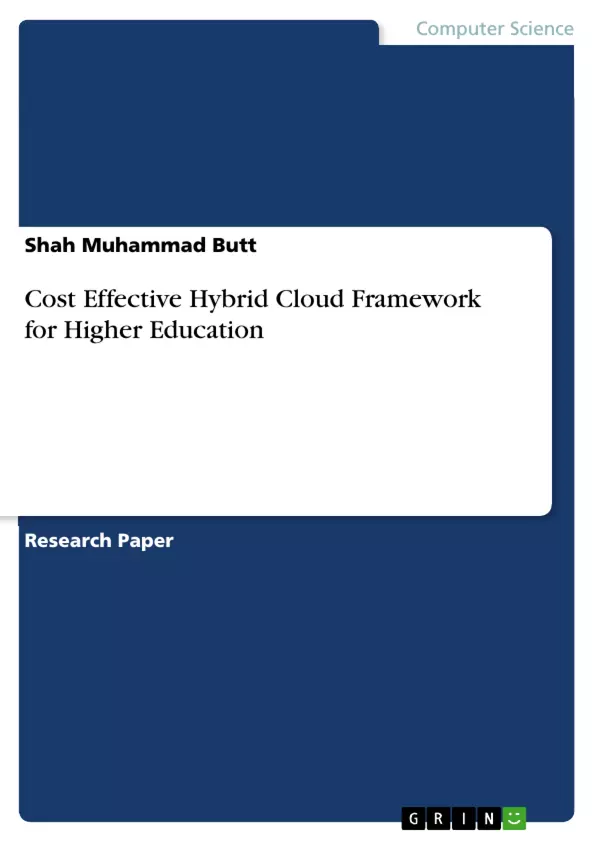Present Financial crisis in Higher Educational Institutes (HEIs) facing lots of problems considerable budget cuts, make difficult to meet the ever growing IT based research and learning needs, institutions are rapidly planning and promoting cloud based approaches for their academic and research needs. A cost effective Hybrid Cloud framework for HEI’s will provide educational services for campus or intercampus communication. Hybrid Cloud Framework comprises Private and Public Cloud approaches. This paper will propose the framework based on the Open Source Cloud (OpenNebula for Virtualization, Eucalyptus for Infrastructure and Aneka for programming development environment) combined with CSP’s services which are delivered to the end-user via the Internet from public clouds: Google, Microsoft, Zoho, Salesforce etc.
Inhaltsverzeichnis (Table of Contents)
- I. Introduction
- II. Background and Related Work
- III. Hybrid Cloud for HEI's of Pakistan
- Hybrid Cloud for Higher Education
- IV. Hybrid Cloud Implementation
- Cloud Design:
- V. Conclusion and Future Work
- Hybrid Campus Cloud Use Cases
Zielsetzung und Themenschwerpunkte (Objectives and Key Themes)
This paper proposes a cost-effective hybrid cloud framework for higher educational institutes (HEIs) in Pakistan, aiming to address the challenges of budget cuts and growing IT demands in the current financial climate. The framework seeks to enable both campus and intercampus communication through a combination of open-source and commercial cloud services.- Cost-effective IT solutions for HEIs in the face of financial challenges.
- Integration of public and private cloud models to provide comprehensive IT services.
- The use of open-source cloud technologies for virtualization, infrastructure, and application development.
- Implementation of a hybrid campus cloud for intercampus communication and collaboration.
- The potential for cloud-based research and development initiatives.
Zusammenfassung der Kapitel (Chapter Summaries)
- I. Introduction: This chapter introduces the concept of cloud computing and its potential benefits for HEIs, particularly in the context of budget constraints and increasing IT needs. The paper proposes a hybrid cloud framework that integrates public and private cloud services using open-source technologies.
- II. Background and Related Work: This chapter discusses the challenges faced by HEIs in providing consistent IT services for learning and research. It explores the different cloud service models (SaaS, PaaS, IaaS) and their potential applications in education. The chapter also outlines the advantages and disadvantages of each model, highlighting the need for hybrid cloud solutions.
- III. Hybrid Cloud for HEI's of Pakistan: This chapter presents the proposed hybrid cloud framework for HEIs in Pakistan. The framework consists of three tiers, each focusing on different aspects of IT service delivery. Tier 1 addresses user access, authentication, and data storage. Tier 2 provides a development environment for applications using open-source tools and cloud APIs. Tier 3 focuses on virtualization and infrastructure management using OpenNebula.
- IV. Hybrid Cloud Implementation: This chapter discusses the challenges and considerations for implementing a hybrid campus cloud. It highlights the need for specialized skills and tools for software development in hybrid environments, emphasizing the importance of managing heterogeneous resources and ensuring secure data integration.
- V. Conclusion and Future Work: This chapter summarizes the paper's main points, reiterating the benefits of a hybrid campus cloud for HEIs in Pakistan. The chapter also outlines plans for future research and development, including the implementation of the proposed framework and pilot testing.
Schlüsselwörter (Keywords)
The paper focuses on the use of cloud computing, specifically a hybrid cloud framework, to provide cost-effective IT services for HEIs in Pakistan. Key terms and concepts include: hybrid cloud, open-source cloud technologies, HEIs, financial challenges, IT infrastructure, intercampus communication, and research and development applications.- Quote paper
- Shah Muhammad Butt (Author), 2013, Cost Effective Hybrid Cloud Framework for Higher Education, Munich, GRIN Verlag, https://www.hausarbeiten.de/document/214421


